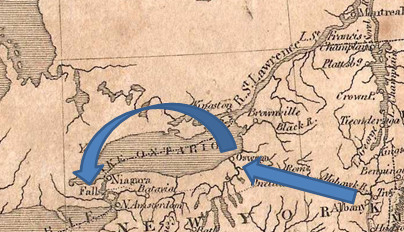

 |

|
|
Campaign of 1813 A small detachment fought at Sacketts Harbor on May 27, 1813 . . . Size unknown. We know from the account of Amasiah Ford, the 23rd Infantry Regiment was present at Greenbush (near Albany) on April 14th where he claims they were mustered. This may be the first time uniformed troops were assigned to officers of the 23rd. Amasiah makes no mention of any training and the 23rd may have gone into combat with only limited drill. Based in this account, it's first reported movement was to Fort Oswego where they remained only a few days and then embarked on small boats for Fort Niagara. The unit arrived at Niagara on May 27th , where they reboarded boats and were landed near Fort George, were a mixed force was assaulting the emplacements. On May 28th the regiment marched to Queenston and then back to Fort George on the 29th. No casualties were reported in this engagement. On June 5th the unit advanced a few miles deeper into Canada to Stoney Creek under the joint command of Generals Winder and Chandler.
The next day, June 6th, in a night engagement at Stoney Creek, the 23rd was attacked by 700 hand picked British troops. In the confused engagement both sides gave way. The 23rd fought on the left flank and casualties were one killed and two wounded plus a number captured including the two commanding Generals: Winder and Chandler. The regiment was forced to withdraw to Fort George on June 8th. On June 23rd an entire company of 63 men under Captain Isaac Roach was captured near Beaver Dams. . . No details of the action remain. Fearful of loosing even a single ship (which could have turned the tide of the war on lake Ontario) the U.S. Naval Commander, Commodore Chauncey, refused to supply the American forces by boat; forcing the withdrawal due to a shortage of ammunition. The unit remained at Fort George all summer, exchanging fire with the enemy almost daily. In the fall, the 23rd Regiment had orders to march and crossed the river back to the American shore under the command of Colonel Bissel, leaving Major Chapin with the only a company in charge of Fort George. The regiment made a forced march of about 18 days by foot across Western New York. Roads were limited to non-existent and the weather was poor, causing much loss of equipment.
The units eventual target was Sackett's Harbor, were they remained camped in tents for the month of December. Heavy falls of snow keep the unit inactive. The tents were eventually replaced by barracks build by the men of the regiment. There were most likely log cabin affairs. The unit was able to say warm in these cabins for only three days when orders came to march to French Mills to reinforce the army under General Wilkinson after its defeat at Crysler's farm. The regiment left camp on December 25th. This march was through the woods as there were no roads in the area at the time. The regiment rested briefly at the village of Malone about twelve miles from French Mills. The regiment left Malone for Chateauguay Four Corners, arriving there at night. The troops again built barracks where we remained in winter quarters there for five weeks and then marched to the French Mills to join the rest of the American army. The regiment spent the night sleeping in the snow and then withdrew to Plattsburgh in the morning.
The regiment again entered winter quarters in Plattsburgh, remaining there until March1814. On March 30th the army under General Wilkinson marched into Lower Canada, attacking the enemy at LaColle Mill. 4,000 U.S. troops attacked 200 dug in British regulars around an old stone mill and a Revolutionary War blockhouse. The American forces open fire with three small cannon which had no effect on the position. After only two hours, the American artillery ran out of ammunition and the planned infantry attack, which the regiment would most likely have been asked to make, was cancelled. The British launched an assault on the guns once they could see that they were out of ammunition, but were driven back by American rifle fire. No casualties were reported and the regiment retreated back to the village of Champlain then moved back to the base at Plattsburgh. There it remained until June 11th when the 23rd Regiment and a detachment of the 22nd were ordered to retrace their steps and march back to Buffalo under the command of Major Mercer Brooke.
|